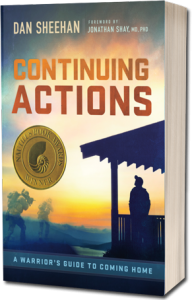Continuing Actions Chapter 3
THE MYTHIC POWER OF WAR
“War is a mythic arena. In its noise and grandiosity, its manipulation of the forces of life and death, and its irrevocable shaping of history and destiny, war transforms the mundane into the epic and legendary.” —Edward Tick, War and the Soul, p.25
WAR HAS BEEN HELD as a rite of passage for thousands of years. Traditionally, it was the crucible boys had to survive in order to become men. Even now, many veterans consider it the dividing line between their own adolescence and adulthood. But even if we value the experiences of war in this fashion, few of us understand why. It’s not as if the soldiers on D-Day were considering “the shaping of history and destiny” as they waited for their landing-craft ramp to drop. Nor were Marines mulling over the “manipulation of the forces of life and death” while patrolling Sadr City. And how many of us felt particularly “epic and legendary” scooping our comrades into body-bags?
Not many. But that’s not to say the statement by Tick is incorrect. In fact, according to men and women who’ve faced combat, as well as those who help them address the challenges of coming home, he’s right on. The experiences of war rate such mystical, grandiose descriptions because they transform those who survive them—often without their knowledge or permission. Even if we refuse to admit it or just don’t see it, the man or woman who emerges from the “mythic arena” of war is not the same as the one who entered.
This is because we’re human, and our battles take place on two levels—outer and inner. The outer battles are the physical ones, the application of explosives, steel, and lead against flesh. They decide victory or defeat on a grand scale and life or death on a mundane one. Their scope and scale make war epic, monumental, and legendary. But they are not what makes war mythic.
The inner battles do that.
For each action taken in an outer battle, each decision made, tragedy observed, or killing skill applied, there is a corresponding battle that takes place within the warrior. These inner conflicts are what healthy human beings experience when they do, see, or experience things that violate fundamental concepts of humanity. And at a basic level, war violates every aspect of humanity. To even observe modern warfare is to question the existence of anything special or evolved in humans. For those who participate in it, this question is not academic—it’s personal. The humanity we question is our own.
Warriors have always had to face these inner battles. The effects of trauma, death, fear, exhilaration, and rage on the human animal have not changed over time. Today’s warrior must protect himself against the same emotions and reactions that might have distracted a Roman Centurion thousands of years ago. But the incredible speed, intensity, and lethality of modern warfare mean he accumulates these emotions and reactions at a greater rate than ever before.
As noted in the previous chapter, successful warriors use compartmentalization to protect themselves from being distracted by these inner battles. We have learned to ignore them in the heat of the moment in order to remain focused on the task at hand. This skill is essential for survival in combat, not to mention attaining victory. But while the conscious mind can be shielded from the inner conflicts, the unconscious mind is not so easily protected. It is filming and recording every event. And not only are the sounds, tastes, and smells captured, but all the emotional reactions we ignored in order to survive are registered as well. Stored away, these memories do not dissipate on their own. They exert pressure from deep within and, over time, twist and distort our consciousness like tree roots pushing up a sidewalk.
Exposure to these inner battles changes the way our unconscious mind operates. It weathers the experiences of combat without protection and is forever changed as a result. The conscious mind, however, was protected from those inner battles by the flak jacket of compartmentalization. It continues to operate as though nothing has happened.
And the chasm begins to form.
Instead of a unified voice, the conscious and unconscious minds now speak different languages, at different volumes, and at different times. At a minimum, this rift is annoying. The wider it gets, though, the more destabilizing it becomes. To warriors struggling to ignore its presence, the disconnect between their conscious and unconscious minds strands them between two worlds; they are living in peace but reacting to war.
This was the case for a young Marine I met a few years ago. He’d been an infantry squad leader in Fallujah and Ramadi during the fighting in 2004. A common insurgent tactic during those bloody battles was to arm children—sometimes with real AK-47s, sometimes fake—and send them toward the Marine positions. It was a win-win situation for the insurgents. If the Marines killed the kids, they could claim atrocities. If not, then the kids might actually open fire or get detonated remotely. It was just one more horrible aspect of war that offered no right answer.
One day this young Marine was manning a .50cal on top of a vehicle, covering a foot patrol as it cleared rubbled houses close to their checkpoint. Suddenly, a boy—couldn’t have been more than six—burst out of a nearby house, pointing a rifle at him.
Reacting instinctively to the movement, the Marine swung his heavy machine gun to engage. Two facts registered simultaneously in his mind: boy and gun. But within a heartbeat the young father stuffed thoughts of his own son away and focused on his mission. The decision to kill the boy or allow himself and his buddies to die was almost made for him. He might have accepted additional risk to himself, but not for his Marines. He began to depress the butterfly trigger.
At that instant, another Marine burst out of an adjacent doorway and knocked the kid over with a flying tackle. The plastic replica AK-47 went flying as the rolling Marine frantically tried to separate himself from the potentially explosive-laden boy. Time stopped as everybody tensed for the explosion that didn’t come. A few moments later the kid scrambled away with bleeding knees and elbows and the patrol moved on, the episode forgotten.
For the Marine with the machine gun, though, the decision to kill a child ripped his conscious and unconscious minds apart. It didn’t matter that he hadn’t actually killed the boy—he’d decided to. Compartmentalization protected his conscious mind from what he’d almost done, but his unconscious mind registered the full impact of that decision. That incident, seemingly forgotten almost instantly, created a chasm between his conscious and unconscious minds that would have lasting consequences.
He made it home from Iraq in one piece—but then his life began to fall apart. Thoughts of being with his family sustained him during his deployment, yet when he got home he withdrew from them all. He felt uneasy around them and refused to play with his young son or go out with his wife. The only place he felt remotely comfortable was indoors and away from anybody else. His coldness and self-isolation confused and hurt his wife initially, but eventually just became their new normal. He was irritable, quick to flash anger, and could never seem to sit still. He didn’t share his experiences in Iraq with anybody, lost touch with the Marines in his squad, and was fundamentally alone.
AFTERMATH
He did receive treatment for PTSD through the Veterans Administration (VA) and even felt minor relief after talking to a counselor there. After multiple sessions, he achieved enough clarity about his situation to engage with his wife and son again, albeit in small doses. Then, after a particularly good day when he was feeling calm and just beginning to believe that things were looking up, it happened.
He was sitting on the couch after playing outside with his son. The TV was on and his wife was in the kitchen making dinner. He wasn’t thinking about anything, really, just sitting there, relaxed. Without warning, his son jumped on his back. Little spindly arms grappled around his neck to get a solid hold for a piggy-back ride or mock wrestling session—but he didn’t notice. All he knew was that he was being attacked.
Rage, pure molten rage, erupted from the core of his soul. He smashed and thrashed and quickly got a hold of something solid. Ripping the boy off his back, he pushed his little body into the couch and cocked his fist to strike. His wife, alerted by the commotion, screamed.
Her scream brought him back to reality. Shaking, he released his grip and let his arm fall to his side. Then he walked away, stewing in self-loathing and guilt that threatened to overwhelm him. The episode might have been smoothed over, maybe he could have laughed it off like he’d been playing or just told his boy not to sneak up on him again. But he couldn’t—he knew he’d been too close. Instead of trying to figure out what happened, he did what so many other veterans have done when war came home with them. He doubled down on compartmentalization and reinforced his mental walls with physical ones. Moving into a cave-like spare bedroom, he withdrew from his family, never coming out if they were around. He just stayed in there alone, isolated, and in pain.
He didn’t know why he’d reacted the way he did. He couldn’t explain why his startled reaction caused him to hate himself with such ferocity. The only thing he was sure of was that the only way to keep his family safe—from him—was to stay away from them.
THE DARK SIDE OF COMPARTMENTALIZATION
If we went through combat fully conscious of our emotions, we probably wouldn’t have to deal with any emotional challenges afterward. Our conscious and unconscious minds would have experienced the same emotions and reactions simultaneously and there would be no chasm to close.
We’d also probably be dead. The distraction of having our conscious mind pummeled by emotional responses would’ve put our comrades, our mission, and ourselves at risk. So we compartmentalized our reactions, protected our conscious mind, and remained focused on the immediate threats to our survival. Each time we did this, the chasm grew wider.
For many of us, compartmentalization keeps us from even realizing the chasm exists. It is only after we come home that the differences between the person who left and the one who returned become apparent—usually to our family members first. If confronted about this change we may be unable to explain why. All we know is we are different now than we were before.
But this phenomenon is not based only in the learned response of compartmentalization. It is also hard-wired into our brains. Pierre Janet, an early pioneer in psychotherapy, was the first to explain how a person can have no recollection of traumatic events yet still be unconsciously influenced by reactions they generated. “Janet noted that post-traumatic amnesia was due to a ‘constriction of the field of consciousness’ which kept painful memories split off from ordinary awareness.” (Judith Lewis Herman, Trauma and Recovery, p.45)
Herman builds on Janet’s work to explain how a normally functioning brain protects us from these memories:
“Traumatic events produce profound and lasting changes in physiological arousal, emotion, cogni- tion, and memory. Moreover, traumatic events may sever these normally integrated functions from one another. The traumatized person may experience intense emotion but without clear memory of the event, or may remember everything in detail but without emotion.” (Herman, p.34)
This split between ordinary awareness and the experiences of war is what lends war a mythic quality. It has this seemingly magical ability to reach in and rewire a person’s unconsciousness without their being aware that it’s happening. This mythic quality implies incredible transformative power, but it is not inexplicable—or unexpected.
The changes wrought by traumatic experiences have always been part of the warrior’s journey. And they are not all bad, either. To a warrior willing to do the hard work to complete their journey, the existence of the chasm offers an opportunity.
Closing the chasm between the conscious and unconscious minds provides the means for the warrior to comprehend his experiences and eventually learn from them. This process breeds wisdom and maturity that is, indeed, mythic. It’s just that we, as modern warriors, have not been taught how to close this chasm—or even that it exists.



